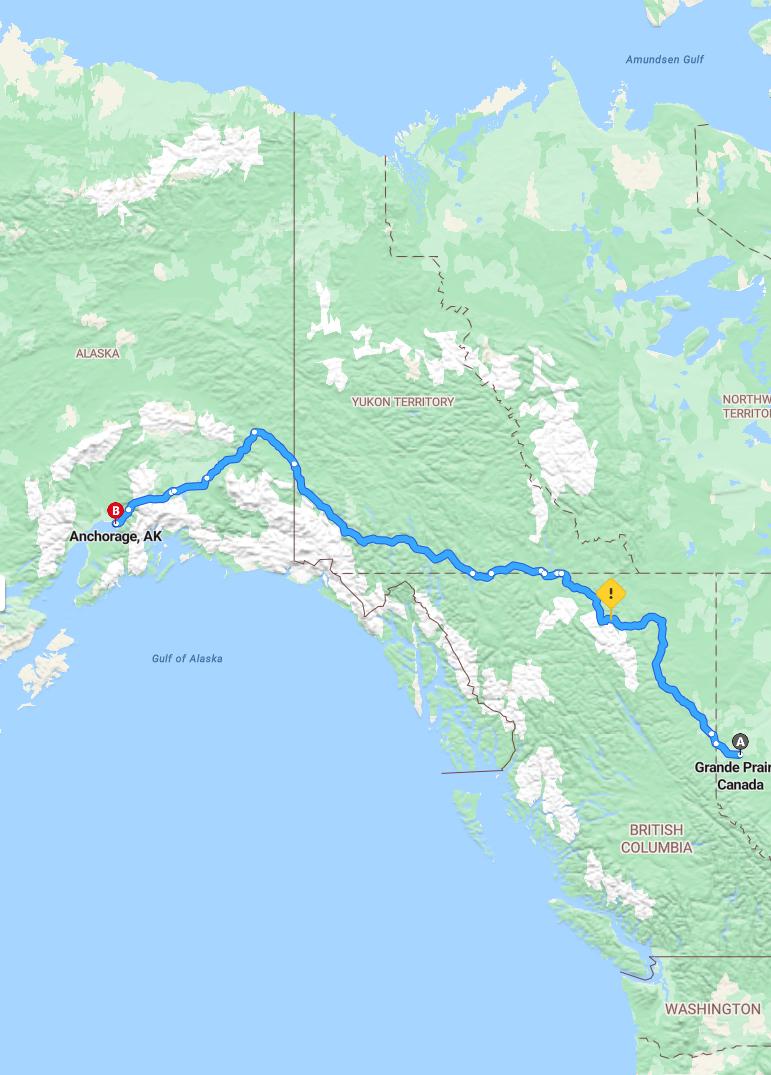Distance and estimated driving time
The drive from Grande Prairie to Anchorage covers approximately 1,657 miles and takes around 28 hours and 50 minutes, offering an adventurous cross-border journey through Canada and Alaska. The route primarily follows BC-97 and YT-1, providing scenic vistas and a diverse range of landscapes along the way. Travelers should plan for rest stops and possible border crossing procedures to ensure a smooth trip. This extensive drive is perfect for those seeking an epic road trip experience through the northern wilderness.
Driving route
Embarking on a road trip from Grande Prairie, Canada, to Anchorage offers travelers an incredible journey through diverse landscapes. Starting in Grande Prairie, travelers will traverse scenic northern Alberta while heading westward, crossing into British Columbia and then into the Yukon Territory. The route encompasses stunning mountain views, expansive forests, and pristine wilderness areas, providing extraordinary photo opportunities along the way. As the trip progresses, travelers will encounter unique cultural sites and natural wonders, culminating in the vibrant city of Anchorage, Alaska. This cross-border adventure promises an unforgettable experience filled with breathtaking scenery and diverse ecosystems.

Road conditions and seasonal considerations
Driving from Grande Prairie to Anchorage requires careful attention to road conditions and seasonal factors. During the winter months, roads can be icy and snow-covered, necessitating vehicles equipped for winter driving and cautious navigation. In warmer seasons, roads are generally clearer, but travelers should remain vigilant for changes in weather and road maintenance activities. Overall, planning for seasonal variations ensures a safer journey through this remote and diverse landscape.
Vehicle preparation and safety tips
Before embarking on a journey from Grande Prairie to Anchorage, it is essential to ensure your vehicle is thoroughly prepared for the trip. Conduct a comprehensive check of the tires, brakes, fluid levels, and overall engine health to prevent any mechanical issues along the way. Pack an emergency kit that includes items such as a first-aid kit, flashlight, extra clothing, blankets, and non-perishable food in case of unforeseen circumstances. Additionally, familiarize yourself with safety tips like obeying traffic laws, staying alert, and ensuring your phone is charged to access emergency services if needed.
Border crossing requirements and documentation
When driving from Grande Prairie to Anchorage, travelers must prepare for the border crossing between Canada and the United States by ensuring they have all necessary documentation. Canadian citizens should carry valid passports or other approved travel documents, along with any required visas if applicable. U.S. customs require travelers to declare any items they are bringing into the country and adhere to regulations regarding prohibited or restricted goods. It is also advisable to carry vehicle registration and proof of insurance to facilitate a smooth crossing and avoid delays.
Fuel stations and rest stops along the route
Driving from Grande Prairie to Anchorage, travelers will find various fuel stations and rest stops along the route to ensure a comfortable journey. Starting in Grande Prairie, several service stations offer convenient refueling options, and as you head south, larger towns such as Dawson Creek and Fort St. John provide additional amenities. Rest stops are spaced out along the highway, offering opportunities for breaks, refreshments, and stretching, which are essential for long-distance driving. It's advisable to plan ahead by identifying key fuel and rest areas to make the trip smoother and more enjoyable.
Local traffic regulations and laws
When driving from Grande Prairie to Anchorage, it's essential to be aware of local traffic regulations and laws in both regions. In Canada, drivers must adhere to strict speed limits, usually posted in kilometers per hour, and prioritize safety by wearing seat belts and avoiding distractions while driving. Upon entering the United States, specifically in Alaska, drivers are required to follow state-specific rules, such as mandatory seat belt use, compliance with speed restrictions, and adherence to alcohol and drug regulations. Additionally, both countries enforce strict laws regarding the use of mobile devices while driving, ensuring safety for all road users along this international route.
Weather forecast and impacts on driving
The weather forecast for the drive from Grande Prairie to Anchorage predicts variable conditions, including the possibility of snow and icy roads, which could significantly impact driving safety. Temperatures are expected to fluctuate, with colder conditions potentially leading to reduced vehicle traction and increased stopping distances. Drivers should prepare for changing weather patterns by checking updated forecasts regularly and ensuring their vehicles are equipped with appropriate tires and safety gear. Caution is advised, especially in mountainous or remote areas, where unexpected weather changes can cause delays and require careful navigation.
Scenic attractions and points of interest
Driving from Grande Prairie to Anchorage offers a breathtaking journey through diverse landscapes full of scenic attractions. In Grande Prairie, visitors can explore the Wapiti River Trails for outdoor recreation and the Grande Prairie Museum for cultural insights. As you traverse through the Canadian Rockies and along the Alaska Highway, you'll encounter stunning vistas of rugged mountains, expansive forests, and pristine lakes. Notable points of interest include Liard Hot Springs, a natural thermal pool perfect for relaxation, and the majestic Kluane National Park in Yukon, renowned for its towering glaciers and abundant wildlife.
Travel insurance and emergency services
When traveling from Grande Prairie to Anchorage, it is essential to have comprehensive travel insurance that covers medical emergencies, trip cancellations, and lost belongings. Ensuring access to reliable emergency services provides peace of mind in case of unexpected situations during the journey. Travelers should review coverage options for both Canada and the United States, as healthcare systems differ between the two countries. Being prepared with appropriate insurance and emergency contacts can significantly alleviate stress and enhance safety throughout the trip.
